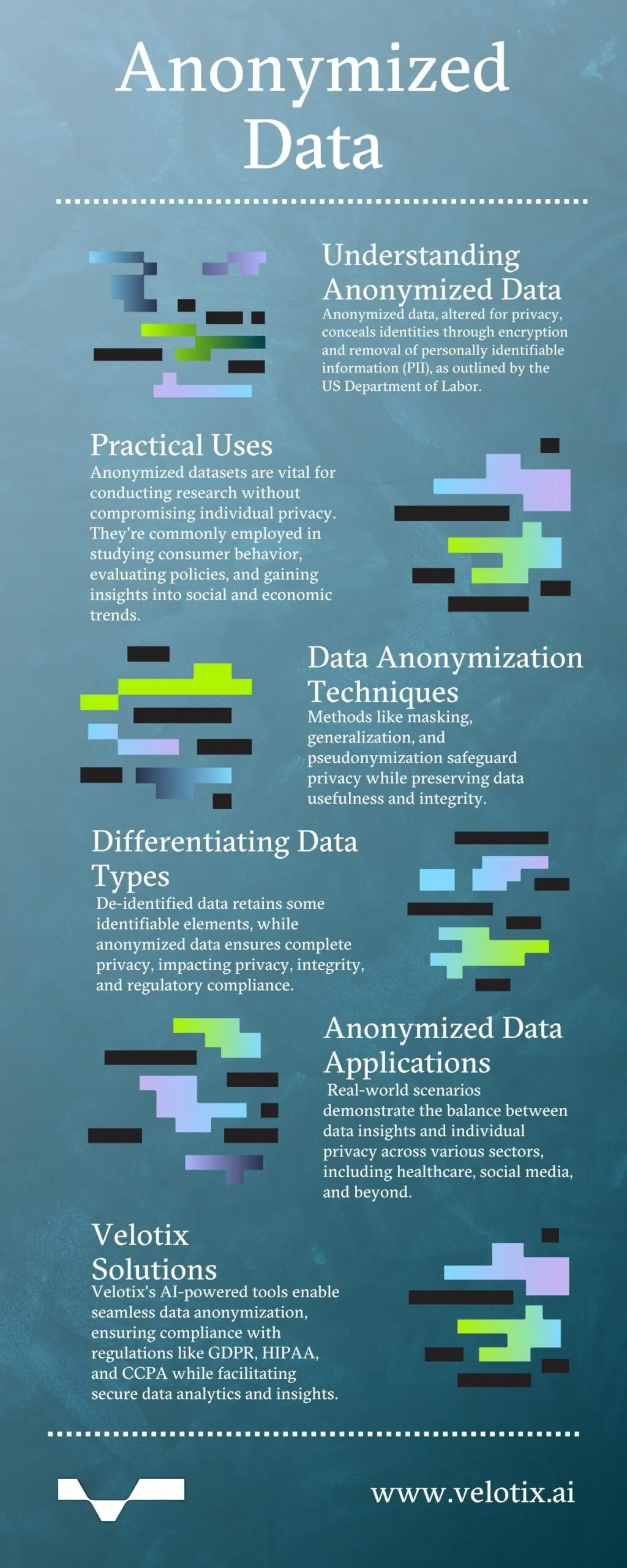What is Anonymized Data?
Anonymized data is data that has been modified in such a way that it can no longer be used to identify the individual it was originally associated with, usually by means of encryption. This is often done by removing personally identifiable information (PII) from the data. According to the US Department of Labor PII is defined as “any representation of information that permits the identity of an individual whom the information applies to be reasonably inferred by either direct or indirect means” and consists of:
- Information that directly identifies an individual, such as name, address, ID number, telephone, or email address
- Information that an enterprise uses to identify specific individuals, such as a combination of gender, race, birth date, or geographic indicators.
- Information that allows for the physical or online contacting of a specific individual
Anonymization is a common technique used in data privacy and security to protect the identity of individuals while still allowing the data to be used for research and other purposes.
Read more: How, When, and Where to Apply Data Anonymization to Your Data Sets
How is Anonymized Data Used?
Anonymized datasets are used when the data set needs to be available for research, but the identity of the individuals it was originally associated with is considered sensitive. This allows all analysts and consumers in the organization to access valuable information without compromising the privacy of individuals & remaining compliant to internal and external regulation.
Common anonymized data uses include:
- The study of trends and patterns in consumer behavior to develop new products and services and to improve existing ones.
- The evaluation of effectiveness of different policies and programs
- Gaining insights into complex social & economic phenomena.
Data anonymization is important for several reasons. First and foremost, it helps to protect the privacy of individuals by removing PII from data sets, which can prevent it from being used for malicious purposes. Additionally, anonymized data sets can be useful for research and other purposes, as they still provide valuable insights and information without compromising the privacy of individuals. Anonymization is an important tool for preserving the confidentiality of personal data and ensuring that it is used in a responsible and ethical manner.

Data Anonymization Techniques
Masking
Also known as data obfuscation, masking means replacing sensitive information with fake, but realistic, data.
Example of masking: using “John Doe” instead of the original first and last name.
Generalization
Replaces specific details in a dataset with more general or abstract information.
Example of generalization: If a dataset contains ages, instead of using specific ages, you would use a range.
Perturbation
Involves adding random noise to specific values in a dataset or randomly shuffling the values.
Example of perturbation:Adding random numbers to each customer’s age to make it more difficult to identify them.
Swapping
Dataset values are rearranged to randomly create a new and unpredictable arrangement
Example of swapping: think of it as shuffling a deck of cards or a playlist- cards & songs are randomly arranged to create a new and varied experience.
Pseudonymization
Using pseudonyms in place of any identifying value, however the original information is not deleted and can be reversed.
Example of pseudonymization:“Jane Doe” becomes “De2b f1”.
Synthetic Data
Replacing real data with artificially manufactured data so that alterations to the original dataset are not necessary.
Example of synthetic data: creating a synthetic version of the data that can be used for analysis without revealing the original data.
Tokenization
Replacing sensitive data with unique identification symbols that retain all of the essential information about the data without revealing the actual data itself.
Example of tokenization: a credit card number will be replaced by different numbers but retain the same format, like 0000-5555-3333-4444.
What is the Difference Between De-Identified & Anonymized Data?
The main difference between de-identified and anonymized data is that de-identified data has had some, but not all, of the personally identifiable information removed, while anonymized data has had all of the personally identifiable information removed. De-identification is a less stringent form of data anonymization, and it typically involves removing certain identifying elements from the data, such as names and addresses, while leaving other information intact.
Anonymization, on the other hand, involves a more thorough process of removing or altering all of the identifying information in the data, making it impossible to use the data to identify individuals. De-identified data may still be sensitive and require protection and it is generally considered to be less privacy-sensitive than anonymized data.
Examples of Anonymized Data
There are many situations where data anonymization may be useful. For example, a healthcare provider may use data anonymization to remove personal identifiers from patient records before sharing the data with researchers for the purposes of medical studies. This allows the provider to comply with privacy laws and regulations, such as HIPAA, while still enabling the use of the data for important research. Another example is a social media company that uses data anonymization to remove personal information from user posts before using the data for analytics or other business purposes. This allows the company to protect the privacy of its users while still gaining insights from the data.
Does Velotix Offer a Data Anonymization Solution?
Data anonymization is a process that allows organizations to extract value from their data while also complying with legal requirements for handling and processing personal information.
Velotix is a solution that uses AI to help identify personal identifiers in data and provide multiple anonymization methods and tools for use cases such as masking, hashing, and bucketing. With Velotix, organizations can gain industry-standard compliance with regulations such as GDPR, HIPAA, and CCPA, and transform their data anonymization processes.
Learn more about our data anonymization tools & contact us to learn more or book a demo.